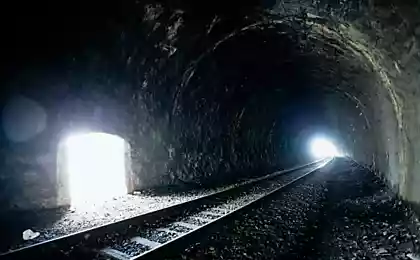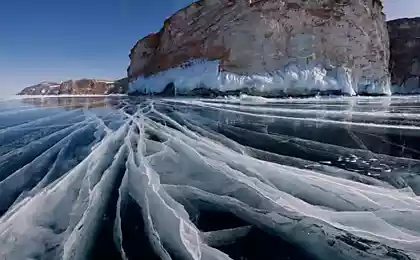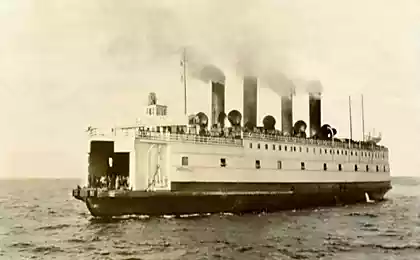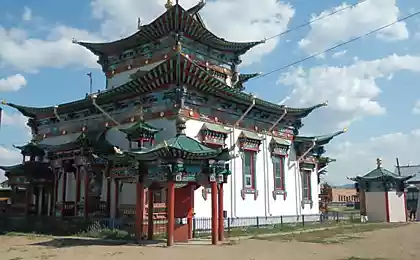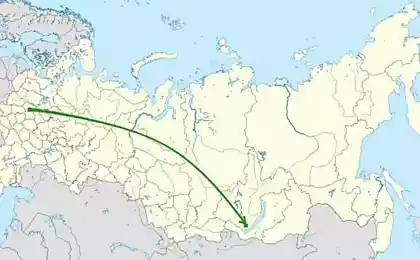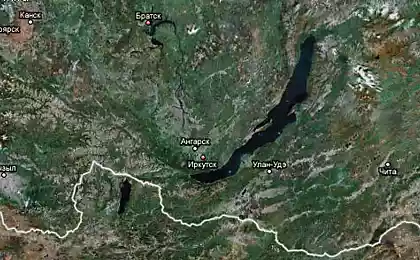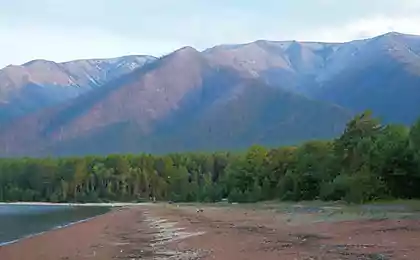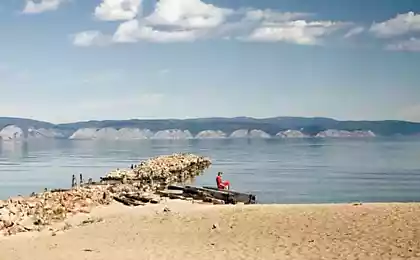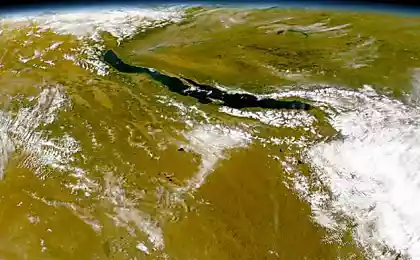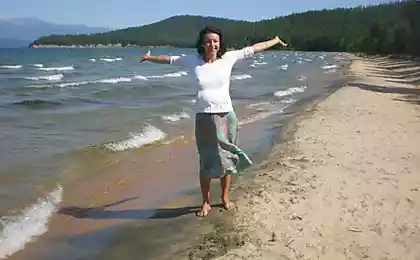575
Baikal. Rare footage
Ladies! Get ready! Now would be a hell of a mi-mi-mi and Oh-x-Oh!
The defenders of nature! Calm down! The hero of the story is all right. He was rescued by our guides and is now gaining weight in caring hands.
Few photographers can boast of such images. To remove the pup ringed seals in natural conditions is very rare. Even many of those who live on the lake, never seen pups in their habitat.
Hi!
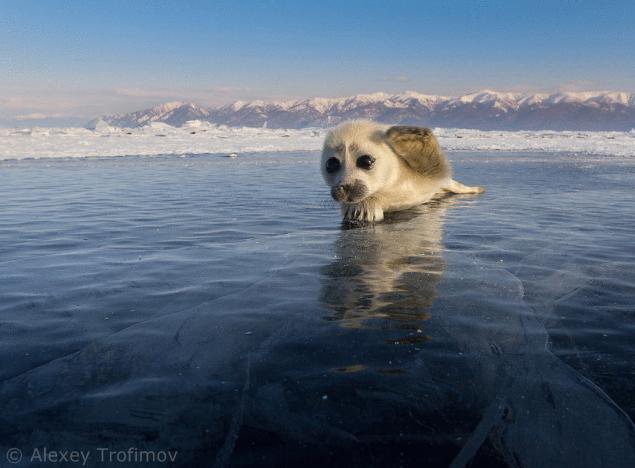
To see from afar the adult Baikal seals is not difficult. The ringed seal inhabits the whole lake. She's curious, but also cautious. Summer traveling across the expanses of lake Baikal can often be seen emerging from the water for a few seconds, a pretty face with huge black eyes. You can sometimes see seals and holidaymakers coastal rocks, but sliding into the water at the slightest attempt to approach them. Close to you seal not admit. Summer on the shore of the Ushkany Islands, where a huge number of these animals. Despite the fact that ecosytem of lake Baikal Nerpa to be on the top of the food chain, she's shy. Upon the slightest suspicion of danger this cute pet is hiding in the depths of the lake. Rookery of Baikal seals I shot last year.

Baikal seal, or Baikal seal (lat. pusa sibirica) is one of three freshwater species of seal in the world, endemic to lake Baikal, a relic of a tertiary fauna. The time of its separation from the common stem of the ancestors — about 20 thousand years.
This animal had largely been the reason for the occupation of lake Baikal, an ancient man in the role of a commodity and deity. She gave fur skins, fat, medicinal properties, and meat. Currently, commercial hunting of Baikal seals is prohibited.
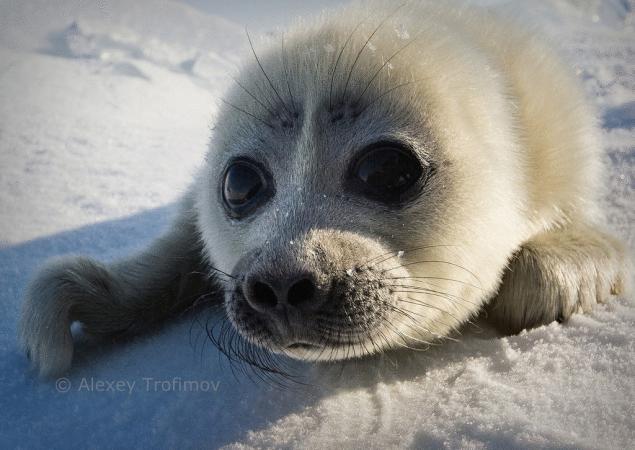
Baikal seal, depending on age, has had several names. The newly born pup of the seal, to the time of molting, when a white or grayish fur changes to dark is called Belek. Young buck – kumai. Adult seal – uscan. Old male-cleaver – ARGAL.
UPD: a Small addition. Pup's first year — kumutkan, second-chubun. Suggested Baikal guide Igor Shramko.
Immediately after on lake Baikal will stand the ice, the seal makes an air hole. While the ice is thin, the seal easily breaks it pressing the bottom face. Thicker ice (2-2. 5 cm) beast breaks only through the shock front flapper. In the thicker ice layer (3-6 cm) the seal makes an air hole powerful claws. The air hole diameter can reach 15-20 cm.
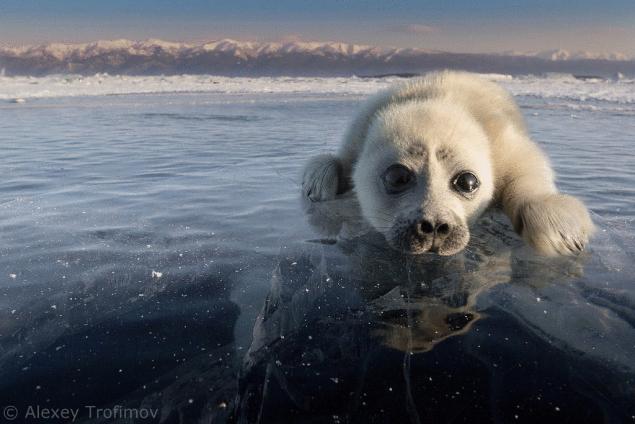
Very rarely, the seal makes an air hole in the hummocks. Usually the seal scratches holes outlet not far from the ridge (1.5-8 m) in a monolithic smooth ice under the cone — shaped snow- snaring. The work is not for one and not for two steps. Already at the initial stage of making an air hole in the ice hemisphere accumulates exhaled air seal. These air bubbles, the seal can use for breathing as carbon dioxide at low temperatures dissolves quickly. And out of the water releases oxygen.
Air bubbles prevent quick freezing of the ice. The ice pierced the bubble destroyed much easier by claws. While the process of ice growth (January to March), the seal is able to make other vents. Including in the ice a meter thick. The hole is of a cylindrical shape and the air chamber in the snow above the hole has the same diameter as the hole.
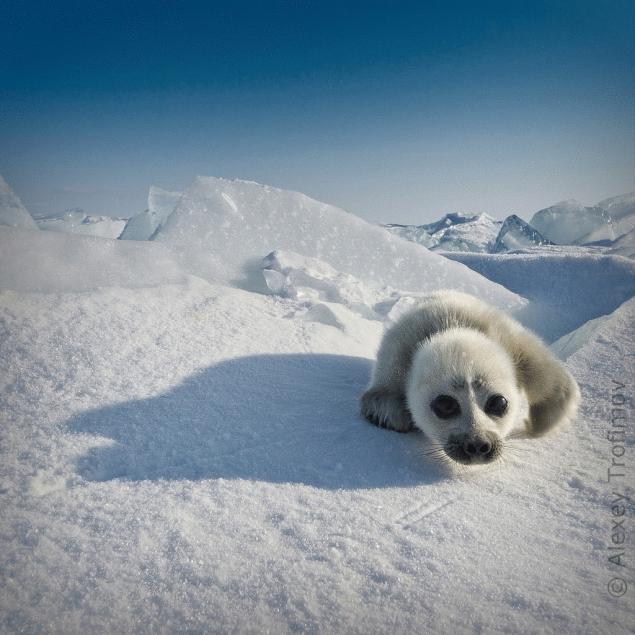
The den is primarily a safe haven for newborns in the early stages of their life from predators, but also from overcooling. From the constant presence of calves and females during feeding, as well as given that within 1-1,5 months the den is not reported to the outside not a single visible hole inside the snow structures formed a kind of microclimate: in the outer 15-20 degrees below zero with strong winds, the temperature inside the den close to zero and to +5 degrees, when it delayed a female. This circumstance has a beneficial effect on the growth of pups.

Especially the role of the dens to protect young animals from birds of prey: carrion crows everywhere, living on the shores of lake Baikal before arriving white-tailed eagles. The wall of the den pups of the seal do not scratch, as trying to hide from the light. They seem to the outside after the roof of the lair itself will collapse due to the melting snow, and the pups of the seal will grow so much that at the slightest danger you can go into the water, where the enemies of the seal no. Finding Nebat in the dens and the location of the last usually in areas of the deep water of lake Baikal, i.e. away from the coast, exclude the possibility of the death of the young seals from terrestrial carnivorous animals — Fox, wolf, sable.

Because of this, that the young seals are constantly hidden in burrows to see Belek is virtually impossible. Rarely, with a strong shifting of the ice, the lair is destroyed and the pup is on the surface. If the mother at this time to be feeding under water or outlet destroyed by the thrust of the ice and the mother may not go back to the lair, nectec in serious danger. First of all, he threatens to attack the ever-hungry carrion crow. On the day of the shooting, while waiting for the conductors near the Big Ushkanyi, I witnessed how a large flock of carrion crows, the recruiting signal kinsman-scout, rose from the trees and flew in the direction of lake Baikal. And fell a few kilometers from the shore of the island. When a few hours, we came to this place, we saw a picture of the tragedy. The ravens mauled arpenia.
You now there!
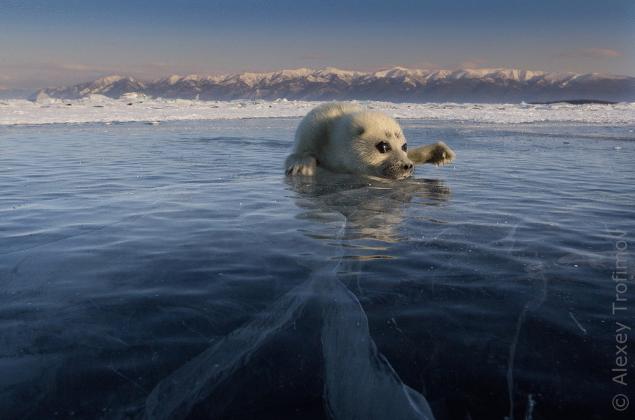
Our hero was in a similar situation. That day we were prospecting North of the Ushkany Islands. Armed with binoculars, with experienced guides, we were looking for the exits of the seal from the dens. Ice no joke moved. come warm weather, the day was positive. This caused strong ice movements. Here, our guide Andrew said on the radio that he sees on the beach. It was a huge luck (for us, of course). The rare case when the mother seal made in Toros. Occurred a change, the Toros pressed. Namety snow layer was destroyed, the blowhole pushed ice. Belek crawled to the surface. He was expected to assume is not difficult. He was rescued, after spending some time in our model.
After the ban on commercial production of the Baikal seal is thriving. Reduced mortality in the first year of life, early puberty, high reproductive potential, large body size, large total weight, exclusive reloadlist, etc. — the result of increased growth rate in the first year of life, the stability of the forage base in lake Baikal. Thus, the seal is an integral part, or rather, the top of the food chain in the ecosystem of lake Baikal. published
Author: Alexey Trofimov
P. S. And remember, only by changing their consumption — together we change the world! ©
Source: alexphotograph.livejournal.com/56107.html
The defenders of nature! Calm down! The hero of the story is all right. He was rescued by our guides and is now gaining weight in caring hands.
Few photographers can boast of such images. To remove the pup ringed seals in natural conditions is very rare. Even many of those who live on the lake, never seen pups in their habitat.
Hi!

To see from afar the adult Baikal seals is not difficult. The ringed seal inhabits the whole lake. She's curious, but also cautious. Summer traveling across the expanses of lake Baikal can often be seen emerging from the water for a few seconds, a pretty face with huge black eyes. You can sometimes see seals and holidaymakers coastal rocks, but sliding into the water at the slightest attempt to approach them. Close to you seal not admit. Summer on the shore of the Ushkany Islands, where a huge number of these animals. Despite the fact that ecosytem of lake Baikal Nerpa to be on the top of the food chain, she's shy. Upon the slightest suspicion of danger this cute pet is hiding in the depths of the lake. Rookery of Baikal seals I shot last year.

Baikal seal, or Baikal seal (lat. pusa sibirica) is one of three freshwater species of seal in the world, endemic to lake Baikal, a relic of a tertiary fauna. The time of its separation from the common stem of the ancestors — about 20 thousand years.
This animal had largely been the reason for the occupation of lake Baikal, an ancient man in the role of a commodity and deity. She gave fur skins, fat, medicinal properties, and meat. Currently, commercial hunting of Baikal seals is prohibited.

Baikal seal, depending on age, has had several names. The newly born pup of the seal, to the time of molting, when a white or grayish fur changes to dark is called Belek. Young buck – kumai. Adult seal – uscan. Old male-cleaver – ARGAL.
UPD: a Small addition. Pup's first year — kumutkan, second-chubun. Suggested Baikal guide Igor Shramko.
Immediately after on lake Baikal will stand the ice, the seal makes an air hole. While the ice is thin, the seal easily breaks it pressing the bottom face. Thicker ice (2-2. 5 cm) beast breaks only through the shock front flapper. In the thicker ice layer (3-6 cm) the seal makes an air hole powerful claws. The air hole diameter can reach 15-20 cm.

Very rarely, the seal makes an air hole in the hummocks. Usually the seal scratches holes outlet not far from the ridge (1.5-8 m) in a monolithic smooth ice under the cone — shaped snow- snaring. The work is not for one and not for two steps. Already at the initial stage of making an air hole in the ice hemisphere accumulates exhaled air seal. These air bubbles, the seal can use for breathing as carbon dioxide at low temperatures dissolves quickly. And out of the water releases oxygen.
Air bubbles prevent quick freezing of the ice. The ice pierced the bubble destroyed much easier by claws. While the process of ice growth (January to March), the seal is able to make other vents. Including in the ice a meter thick. The hole is of a cylindrical shape and the air chamber in the snow above the hole has the same diameter as the hole.

The den is primarily a safe haven for newborns in the early stages of their life from predators, but also from overcooling. From the constant presence of calves and females during feeding, as well as given that within 1-1,5 months the den is not reported to the outside not a single visible hole inside the snow structures formed a kind of microclimate: in the outer 15-20 degrees below zero with strong winds, the temperature inside the den close to zero and to +5 degrees, when it delayed a female. This circumstance has a beneficial effect on the growth of pups.

Especially the role of the dens to protect young animals from birds of prey: carrion crows everywhere, living on the shores of lake Baikal before arriving white-tailed eagles. The wall of the den pups of the seal do not scratch, as trying to hide from the light. They seem to the outside after the roof of the lair itself will collapse due to the melting snow, and the pups of the seal will grow so much that at the slightest danger you can go into the water, where the enemies of the seal no. Finding Nebat in the dens and the location of the last usually in areas of the deep water of lake Baikal, i.e. away from the coast, exclude the possibility of the death of the young seals from terrestrial carnivorous animals — Fox, wolf, sable.

Because of this, that the young seals are constantly hidden in burrows to see Belek is virtually impossible. Rarely, with a strong shifting of the ice, the lair is destroyed and the pup is on the surface. If the mother at this time to be feeding under water or outlet destroyed by the thrust of the ice and the mother may not go back to the lair, nectec in serious danger. First of all, he threatens to attack the ever-hungry carrion crow. On the day of the shooting, while waiting for the conductors near the Big Ushkanyi, I witnessed how a large flock of carrion crows, the recruiting signal kinsman-scout, rose from the trees and flew in the direction of lake Baikal. And fell a few kilometers from the shore of the island. When a few hours, we came to this place, we saw a picture of the tragedy. The ravens mauled arpenia.
You now there!

Our hero was in a similar situation. That day we were prospecting North of the Ushkany Islands. Armed with binoculars, with experienced guides, we were looking for the exits of the seal from the dens. Ice no joke moved. come warm weather, the day was positive. This caused strong ice movements. Here, our guide Andrew said on the radio that he sees on the beach. It was a huge luck (for us, of course). The rare case when the mother seal made in Toros. Occurred a change, the Toros pressed. Namety snow layer was destroyed, the blowhole pushed ice. Belek crawled to the surface. He was expected to assume is not difficult. He was rescued, after spending some time in our model.
After the ban on commercial production of the Baikal seal is thriving. Reduced mortality in the first year of life, early puberty, high reproductive potential, large body size, large total weight, exclusive reloadlist, etc. — the result of increased growth rate in the first year of life, the stability of the forage base in lake Baikal. Thus, the seal is an integral part, or rather, the top of the food chain in the ecosystem of lake Baikal. published
Author: Alexey Trofimov
P. S. And remember, only by changing their consumption — together we change the world! ©
Source: alexphotograph.livejournal.com/56107.html
For the first time captured the light of the exoplanet in the visible spectrum
Five original tomato soups from around the world
